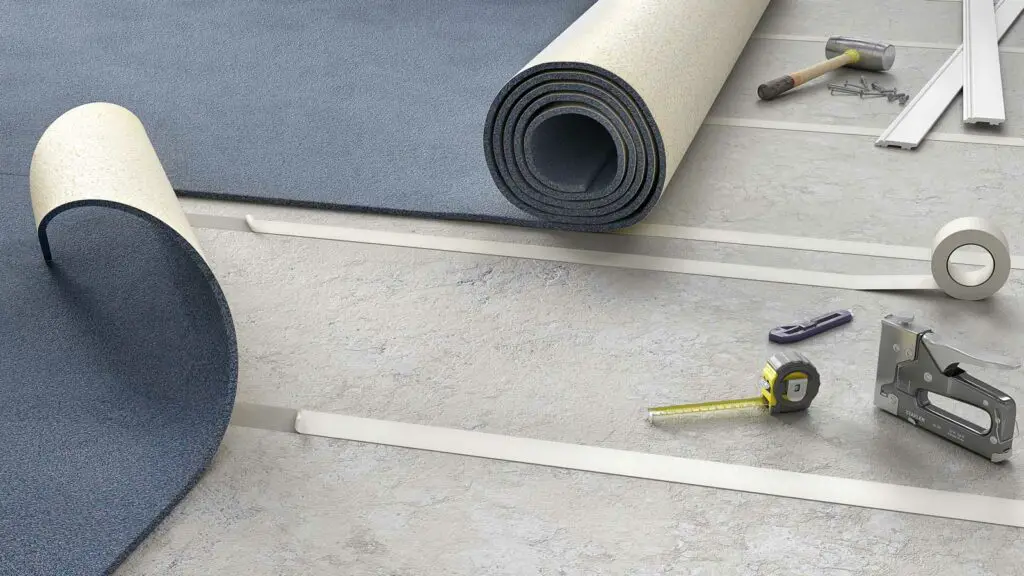So, the time has come to remove your old carpet, has it?
Whether you are going to replace it with a new carpet, or you are switching from carpet to hardwood or tile, you will need to remove all of the carpet staples in order to avoid damaging your subfloor.
So what’s the easiest way to easiest way to remove carpet staples without damaging your floor?
The easiest way to remove carpet staples is start by cleaning up the area with a broom and a shop vac, then using a heavy duty staple remover, slide it underneath the staple itself, and gently work it out. If you need some extra leverage, grab a pair of pliers, or a flathead screwdriver to work it out.
Removing old carpet and their staples yourself will help save you money in the long run, since the cost of carpet removal can really add to your bill.
But what do you do if you run in to carpet staples that are stubborn and hard to remove?
Can you leave your old carpet tack strips if you’re just replacing your carpet?
If you want to remove carpet staples safely and quickly, then read on. I’ll tell you how to do it without hurting yourself or damaging your floors.
By the way – before we get too far along here, if you want to connect with other homeowners and builders and get more great ideas for your home to make your space the best join my free private Facebook group, Remodel Reality here.
How to Remove Carpet and Carpet Padding
Before reaching the carpet staples or the carpet tack strips, you will need to remove both the old carpet and the carpet padding.
This may seem easy enough to do, but there are a few tricks that you should know for easy carpet removal.
First, you want to grab the corner of the carpet with a pair of pliers. Finish pulling the carpet up with your hand if it is easy enough. If it is a little tougher to pull up, you may want to consider cutting a square out of the corner. This should make it easier to pull the rest of the carpet up.
Continue pulling back your old carpet in three feet sections, cutting those sections off, and rolling them up. This will make for more manageable pieces of carpet for you to deal with. Secure the rolls of carpet with duct tape and continue removing the old carpet in this same way until done.
These carpet rolls can either be disposed of by local trash haulers or, if it is in good shape, you can contact carpet recycling programs to send your old carpet. After the carpet has been removed, you will be left with the carpet padding. This padding will either be held down by carpet glue or with carpet staples.
If it is glued down, you probably have a concrete subfloor, and you can use a sharp-bladed floor scraper or another sharp blade to remove all of the glue on your subfloor. You may also want to consider buying some commercial adhesive remover to help make this process a little quicker.
How to Remove Carpet Tack Strips
If you are replacing your old carpet with a new carpet, it is usually okay to leave the old carpet tack strips in place for the new carpet. However, if the old tack strips are damaged or rusted, you may want to consider replacing them. If you plan on installing a new type of flooring, such as tile or hardwood flooring, you will need to remove the tack strips completely. Though there are several important steps to remember while removing carpet tack strips, it is a relatively easy job to complete.

Once removed (remember to be careful of the staples and any splinters that you may get from the strips, make sure to dispose of them properly before continuing your home improvement project.
What About Stubborn Carpet Staples?
You may have carpet that has been stapled down to the subfloor, but how do you remove those staples without damaging your subfloor?
Carelessly ripping out carpet staples can leave holes and more damage to your subfloor, but luckily there is a fairly easy method to removing these carpet staples.
All you need for this method of removing carpet staples is a flathead screwdriver and a pair of pliers. Simply slide the screwdriver under each individual staple and lift it out of your plywood subfloor. Finish removing it with the pliers, and you are good to go.
However, this method may not be the best method to go with, especially if you discover that there is hardwood installed beneath your carpet. Not only is this method agonizingly slow (remember, you will need to lift up each staple individually), but it can also damage your hardwood or subfloor. As you slide the screwdriver under the staple, you will run the risk of scratching up the flooring underneath it, and that is something you will want to avoid doing if you can.
That brings us to the second way to remove carpet staples: the certified easy way. For this method, all you will need is a pair of pliers and a heavy-duty staple remover; that’s it! Simply slide the tip of the staple remover under the carpet staple and push the handle down. This will pop the staple out of the floor quickly and easily. With this method, you will be able to remove hundreds of staples in a relatively short amount of time. When you have removed all of the staples, make sure to double-check for any stray staples that you may have left behind.
How to Remove Broken Carpet Staples
After your carpet has been installed for a while, normal wear and tear are bound to happen. When it comes time to remove your old carpet, you may notice that some of the carpet staples used to hold the carpet padding down are broken. Not only can this cause additional damage to your subfloor, but it can also cause hazards in that room. Nobody would like to step on that broken carpet staple and get stabbed in the foot with it. Luckily, there are ways to pull up even broken carpet staples.
There are several methods for removing broken carpet staples. One of the methods involves using a pair of channel lock pliers or even regular pliers with metal nosing to simply pull the broken staple out. However, this is not always the best way; the carpet staple can easily break off, making it even harder to remove than it was previously. Another option is to use a soldering gun to first heat the staple up; this should help the staple slide out much more easily.
Replacing your old carpet with another type of flooring can be an exciting time for a homeowner. However, that excitement can quickly turn to dismay after observing all of the carpet staples that need to be removed. But do not fear! With a little practice, removing those carpet staples will be as easy as pie!
Next Steps
Want to join others who are creating the most amazing home redesigns & renovations and get more tips, tricks and hacks on how to make your home the best it can be?
Join my brand new free private Facebook group, Remodel Reality to connect with other people like you to make your space the best!







